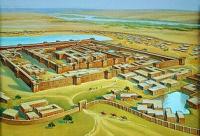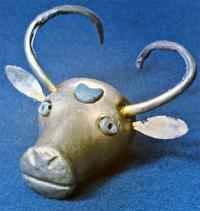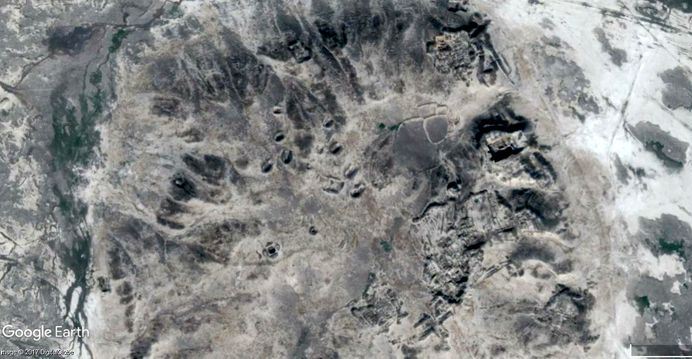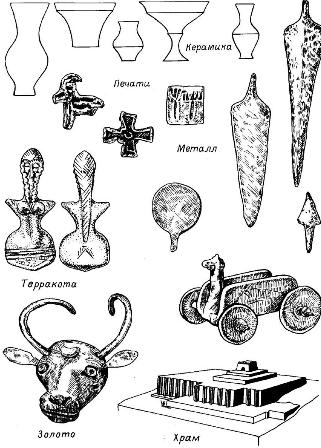You are here
Altyn-Depe ancient settlement.


Heritage tourism in Turkmenistan.
"Altyn had fortress walls of adobe brick, their gates leading into the compact-built "town", were framed with massive pylons. Monumental cult complex with zikkurat dedicated to the God of the Moon served the centre of the town"
Camel Riding in Turkmenistan.
The Altyn depe settlement is located on a natural hill 301.2 meters above sea level, 19.4 kilometers northeast of the Kat mountain range, 2.9 kilometers southeast of the village of Meana, 12.2 kilometers north and slightly west of the Akchadepe village, 58.3 kilometers south and slightly west of the town of Tejen in the Kaakhi etrap of the Akhal velayat.
Golden Hill - this was the name of the city of Altyn Depe of the Bronze Age (III - II millennium BC) on the territory of ancient Abiverd. For the civilization Altyn Depe, dated 2300 - 1900. BC e., many features inherent in the cultures of the ancient East are characteristic.
It was formed on the basis of the development of local agricultural and pastoral communities, which in the V-IV millennium BC. e. mastered the smelting of copper, began to breed cattle, and then camels. Small canals were built to irrigate fields - this was the beginning of irrigation agriculture.
As established by archaeologists, already in this period, Central Asian farmers had close ties with the ancient centers of other civilizations of the East, primarily Asia Minor. The largest centers of the first Central Asian civilization were two urban-type settlements - Altyn Depe and Namazga Depe.
These "proto-cities" were surrounded by fortress walls made of mud bricks, with gates reinforced with powerful pylon towers. Judging by the area of the ruins, about 11,000 - 12,000 people lived in each of them. The formless adobe hills of Altyn Depe, different in area and height, are scattered over a vast territory.
All these architectural symbols are connected into a single system. They form a kind of inscriptions or patterns, clearly visible from above. The settlements Altyn Depe, Namazga Depe and Ulug Depe and others - originated in the III millennium BC, and by the beginning of the II millennium BC. they reached their peak, becoming the largest centers of the first Central Asian civilization.
hese settlements were surrounded by fortress walls made of mud bricks, with gates fortified with powerful towers. Multi-room houses were built from adobe bricks, united into vast quarters, between which narrow winding streets flowed.
The center of Altyn Depe was a monumental temple with a four-step tower about 12 meters high. A sacrificial altar was built on top of the tower. The architecture of the temple in Altyn Depe resembles the buildings of Babylon and Sumer.
Like many temples in Mesopotamia, the temple in Altyn Depe was dedicated to the god of the moon. This huge complex included numerous vaults, the house of the high priest and the tomb of the priestly community.
The ruins of the craft quarters of Altyn Depe stretch for many tens of meters. Among the ruins of the potters' quarter, one now and then comes across the collapsed vaults of massive furnaces for firing pottery. The foundry workers of Altyn Depe achieved great art.
They made magnificent daggers, vessels, mirrors, pins, rings, bracelets, seals, often decorated with chasing and engraving. In the tombs located in the “nobility quarter”, archaeologists have found a variety of jewelry, including gold and silver, necklaces made of semi-precious stones, silver and bronze rings and seals.
A significant part of the residents of Altyn Depe and Namazga Depe worked in the fields irrigated with the help of a simple system of irrigation canals. The inhabitants of Altyn Depe used wheeled carts. We do not know the ancient name of this country and its cities.
The language of its ancient inhabitants is also unknown to us. The swollen hills, under which the ruins of the settlements of the first Central Asian farmers are hidden, today bear much later names, under which these settlements are known in the archaeological literature.
The ruins occupy the top of a 20-meter hill formed by powerful cultural layers. Once the settlement was well fortified: it was surrounded by powerful walls up to 6 meters thick, built of raw bricks. The northern outskirts of Altyn Depe were occupied by houses and workshops of artisans.
Residential quarters were located in the western part of the settlement. It was based on a massive platform measuring 27 x 10 meters. Probably, the very appearance of the massive tower-platform was inspired by the images of the Mesopotamian ziggurats.
During excavations in the tomb, a golden bull's head was found with a turquoise insert on the forehead in the shape of a moon disk. Another line of cultural ties of the ancient farmers of Altyn Depe leads to the Indus Valley - to Mohenjo-Daro, Harappa, to other cities and settlements of the ancient Harappan civilization.
In Altyn Depe, among the things laid in the graves, in the treasures walled up in the walls, Harappan products made of ivory, seals of the Harappan type were found. Many of the most varied products of local origin - from clay vessels to copper daggers and earthenware beads - resemble the products of the artisans of ancient India.
Probably, Indian things were well known to the inhabitants of Central Asian cities and were very popular, which gave rise to a number of local imitations. All these facts clearly indicate that the Altyn Depe civilization developed in close contact with the main cultural centers of the ancient East, being a kind of bridge between Mesopotamia and the cities of the Indus Valley.
Trade caravans left Altyn Depe and to the “civilized” south, to the flourishing cities of Elam and Babylonia, and to the north and east - to the regions inhabited by semi-barbarian nomadic tribes. Archaeologists find the products of the Altyn Depe masters at a distance of 500 - 600 kilometers from the center of their production - in Tajikistan, in the Fergana Valley.
Such contacts contributed to the all-round flourishing of crafts and culture. Many artisans of various specialties lived and worked in Altyn Depe. The ruins of craft districts stretch for many tens of meters. Among the ruins of the potters' quarter, one now and then comes across the collapsed vaults of massive furnaces for firing pottery.
“Their thick walls were almost completely calcined - the temperature of the flame raging inside rose to almost 1400 ° C. At this temperature, the production of earthenware is quite possible, and it is not surprising that the ancient potters were able to make vessels, the thickness of the walls of which is often only a few millimeters.
Their products were a true decoration of the everyday life of the ancient townspeople. Slender vases on high chiseled legs, light goblets with a whimsical curvature of the walls, graceful jugs of elongated proportions characterize not only the perfected skill of ceramists, but also the presence of stable canons, a kind of fashion for sets of a strictly defined composition.
A thin ringing shard of four thousand years ago is often not inferior in quality to modern porcelain. Earthenware, found by archaeologists in almost a fabulous abundance, testifies to the high level of ceramic art of the first citizens of the south of Central Asia."
The foundry workers of Altyn Depe achieved great art. From alloys of copper with arsenic or lead (arsenic and lead bronze) or brass - an alloy of copper and zinc - they made magnificent daggers, vessels, mirrors, pins, rings, bracelets, seals, often decorated with chasing and engraving.
Silver was used both for small jewelry and for more massive items. A significant part of the inhabitants of the "proto-cities" worked in the fields irrigated with the help of a simple system of irrigation canals. Judging by the numerous clay models of carts, mainly four-wheeled, camels were used as a draft force.
Ordinary community members, artisans and farmers lived in multi-room houses, which consisted of cramped closets. Large houses of chiefs and priests had the correct layout and occupied an area of 80 - 100 square meters.
In the tombs located in the “nobility quarter”, archaeologists have found a variety of jewelry, including gold and silver, necklaces made of semi-precious stones, silver and bronze rings and seals. In one of the burials, discovered by archaeologists, a priestess or sorceress was probably buried.
A middle-aged woman lying on her side was clutching two female figurines in her hand studded with gold rings, next to her lay a silver seal in the form of a fantastic three-headed animal. Here archaeologists have found about a hundred beads of agate, carnelian, lapis lazuli and gold. In the middle of the II millennium B.C. e. the settlements of this ancient civilization of Central Asia are declining.
The main cultural center moves to the east, where new settlements of sedentary farmers appear in the delta of the Murgab River and along the middle reaches of the Amu Darya. Many features of this culture make it possible to consider the inhabitants of these oases as direct descendants of the creators of the Altyn Depe civilization.
But at the same time, a number of new, fundamentally different features appear in their culture.
Geographic coordinates of the Altyn depe settlement: N36 ° 51'29.39 "E60 ° 25'55.35"


Authority:
On materials of information department of the State committee of Turkmenistan on tourism and sport.
http://oldevrasia.ru Andrey Nizovsky. "100 Great Archaeological Discoveries". M .: Veche, 2002







